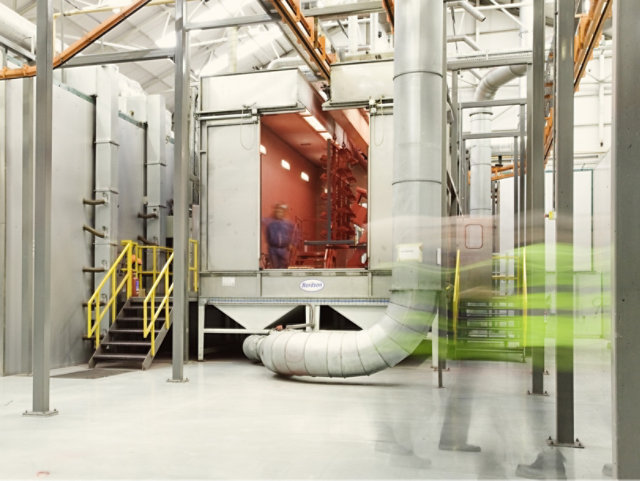
Mastering the Finish
4 Ways to Reduce Cure Time and Increase Throughput
With Elena Ortega Velasco, Engineering Manager
In this guide, Elena Ortega Velasco shares four proven ways manufacturers can reduce cure time while maintaining coating performance, helping your increase throughput and save on energy.
With the right approach, you can improve your finishing line without major equipment overhauls.
Cure time can be a major bottleneck in the finishing process, limiting production speed and increasing energy costs. But small changes can make a big impact. Below are some ways that you can optimize cure times for your line.
Improve Hanging Configurations
The way parts are hung on the line can affect both application efficiency and cure time. A poorly arranged setup forces painters to move around the part, slowing down production and increasing labor time.
Best Practices for Hanging Configurations:
- Maximize rack density - arrange parts strategically to fit more in the same oven space without sacrificing coating quality.
- Reduce movement for painters - position parts so painters can coat them efficiently without having to walk around the line.
- Angle parts for better coverage - hanging parts at an angle can improve coating uniformity and heat distribution and minimize touch-ups.
Key to Mastering the Finish- Optimizing Part Placement
To increase throughput while reducing manual labor, ensuring a smoother more efficient finishing process.

Optimize Your Oven for Better Heat Distribution
Your curing process is only as efficient as your oven. Poor heating distribution can lead to longer cure times and inconsistent finishes.
Key Adjustments to Consider for Optimizing Heat Distribution
- Improve Airflow - Increasing oven air velocity improves heat transfer without requiring more heating energy, reducing oven cycle time.
- Run a Thermal Profile Test - Sherwin-Williams uses thermal profiling to identify inefficiencies in oven performance and recommend targeted improvements.
Key to Mastering the Finish- Testing Oven Heat Distribution
Collaborate with industry experts to test your oven's heat distribution and airflow to ensure consistent curing and avoid unnecessary slowdowns. For powder coating operations, consider adding an infrared (IR) oven to heat parts quickly before entering the high velocity section of the oven, reducing total cure time.

Tailor Cure Times to Part Size
Not every part needs the same amount of time in the oven.
Manufacturers can maximize throughput by designing oven systems and/or conveyor speeds to move small parts through faster while larger parts cure at a slower rate.
Why This Matters
- Eliminates unnecessary delays and lowers risk of over-curing smaller components
- Ensures uniform quality across all parts
- Reduces overall energy use by curing parts at the right speed
Key to Mastering the Finish
Collaborate with a trusted coatings provider to ensure your curing process meets product specifications.

Explore New Technologies & Formulations
One way to reduce cure times is to switch to low-cure powder coatings. Traditional powders cure at 180°- 200℃ (350° - 400℉), but Sherwin-Williams offers options that cure at just 160℃ (320℉).
Why This Matters
- Faster cure times can reduce cycle times, allowing you to coat more units per day.
- Lower energy costs save money on gas and electricity.
- Less energy consumption can also mean a smaller carbon footprint.
Key to Mastering the Finish -Switch to a Low-Cure Powder
Switching to a low-cure powder can help you increase throughput without modifying your existing oven, saving both time and energy.

How Can Sherwin-Williams Help?
At Sherwin-Williams, we help manufacturers optimize their coating process. When you purchase our coatings, you get access to a team of experts dedicated to ensuring your process is efficient and streamlined.
Our mission is to protect and enhance manufactured goods, responsibly.
Meet the Contributor
Elena Ortega Velasco
With six years at Sherwin-Williams, Engineering Manager Elena Ortega Velasco brings a global perspective to industrial finishing. Starting her career in the U.S. before transferring to Europe, Elena has helped build and expand engineering capabilities across regions.
Her expertise lies in optimizing finishing processes for manufacturers, whether through line design, throughput improvement or energy-saving strategies.
Elena works closely with sales and technical teams to audit production lines, identifying areas where customers can enhance efficiency and reduce costs.
Elena is passionate about problem-solving and finding practical solutions tailored to each customer's unique set-up.
With her deep industry knowledge and hands-on experience, she ensures manufacturers get the most out of their coating processes, without sacrificing quality.

How Can Sherwin-Williams Help?
Our mission is to protect and enhance manufactured goods responsibly.
Let Sherwin-Williams help you optimize your coating process.